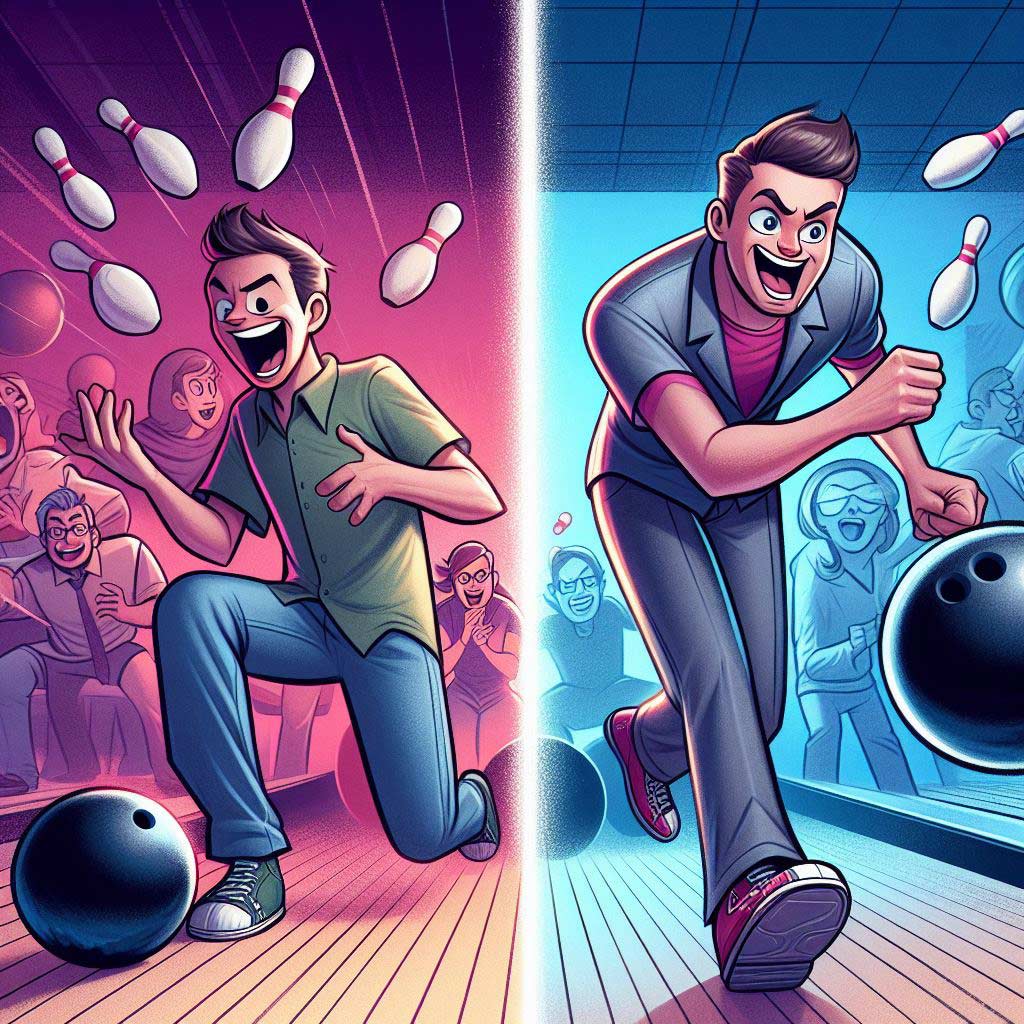Bowling is one of the most popular recreational activities and participatory sports in the United States. Over 70 million Americans enjoy hitting the lanes every year, making bowling the country’s second most participated sporting activity after basketball.
For many beginners or those who have never bowled before, one of the most common questions that come to mind is “Is bowling hard to learn?” The answer to that question depends on several factors.
In this comprehensive guide, we will analyze the various physical, technical, and mental skills required for bowling.
We’ll look at the key elements that contribute to bowling’s difficulty for a beginner, as well as discuss how it gets easier with proper instruction and regular practice. Read on to find out just how difficult bowling is!
The Physical Demands of Bowling
Perhaps the most apparent contributor to bowling’s difficulty is the physical strength and fitness required. Here are some key physical factors that make bowling challenging:
Throwing a Heavy Ball Repeatedly
The average bowling ball weighs between 10 to 16 pounds. While the weight may not seem much when picking it up, having to swing and throw that ball repeatedly can take a heavy toll on the body.
Bowling balls are dense rubber or plastic spheres meant to knock down pins with force. Generating that power requires using larger muscle groups all over the body from fingers to shoulders. The weight and repetitive motion can be fatiguing even for experienced bowlers.
For beginners starting, launching a 10-pound ball feels akin to a moderate strength training workout. Lifting weights that challenge your limits and doing reps till failure.
The lighter house balls provided by bowling alleys are meant to accommodate beginners and children. But most avid bowlers eventually invest in their own custom-fitted heavier ball.
This is why physical strength and some level of muscular endurance are required just to get through a full game without getting worn out, let alone compete at a high level.
Pro bowlers have greater muscle mass and strength to throw maximum power consistently without tiring.
Full Body Movement and Coordination
Far from just being an arm sport, bowling utilizes complex full-body motor skills and coordination. The fingers, wrist, arms, shoulders, chest, back, and legs are all active parts of the throwing motion.
Fingers and wrist control the delicate release of the ball, arms provide the backswing and downswing force, the back and shoulders rotate for added power, and the sliding leg motion propels the throw forward. Mastering the nuanced sequence of movements takes time.
The swing starts from the back, moving the ball behind the body using a pendulum motion. Steps are taken with the opposite foot to build momentum that transfers to the swing.
At the foul line, the bowler must slide ahead on the foot they step with while keeping the swing arm straight to launch the ball.
This multi-step sequence blending balance, coordination, weight transfer, and precise timing is a complex skill to consistently execute.
Proper technique minimizes injury risk and unleashes optimal throwing power. Beginners struggle with maintaining form, balance, release, and follow-through.
The Slide and Release
A key part of the bowling approach is the final slide step. As the swinging arm reaches the bottom of its arc parallel to the floor, the bowler slides their opposite foot ahead almost in a controlled fall. This adds momentum and weight transfer while keeping the swing arm straight to guide the ball.
Sliding instead of planting the last step enables a smoother, more controlled release. But learning to slide while not losing balance or footing takes practice.
Sticking the smooth slide repeatedly with exact timing is tricky to master. Falls and friction burns are common rookie experiences.
The thumb and finger holes of bowling balls are precisely fitted and positioned for each bowler. The biggest challenge is learning to grip the holes correctly, hold on till the optimal release point, and then open the fingers smoothly to launch the ball.
Dropping the ball accidentally or getting fingers stuck at release leads to wayward throws. The thumb and finger muscles need conditioning through repetition to master bowling’s specialized grip and release method.
Risk of Injury
The intense physical exertion required in competitive bowling does carry injury risks like any sport. The fingers, wrist, elbows, and shoulders bear the most strain from the heavy swinging motion. Knee, leg, and back problems can also occur from the quick side-to-side body rotations.
Without proper rest, overtraining, and using poor form, bowlers are prone to strains, sprains, tendonitis in wrists & fingers, shoulder impingement, back issues, and knee ligament tears. Learning the right bowling biomechanics and building strength reduces injury risk significantly.
The Technical Skills You Need to Master
Beyond athleticism and fitness, bowling also requires specific technical skills that take time and coaching to master:
The Proper Grip
The biggest technical key is mastering the finger and thumb holes gripping system of bowling balls. The grip affects everything from swing, release, speed, power, aim and hook potential.
Incorrect grip leads to inconsistent throws and tighter grip causes finger strain. Learning the optimal pressure and which fingers to relax is important. There are different prescribed grip styles like the conventional, fingertip, or two-handed approach.
Picking the right grip style, finger hole size, proper hand placement, and grip pressure are foundations on which a coach trains new bowlers.
Arm Swing Technique
The free-swinging pendulum motion of the bowling arm is a skill in itself. Keeping the arm straight on the backswing, achieving the proper height, and maintaining that plane on the downswing requires practice.
The ball is swung behind the back and then forward like moving a swing. The key is hitting the sweet spot of the arc at the release point. Rushing the swing or bending the elbow leads to inconsistent throws.
Body balance during the forward swing, coordinated timing with the foot slide, and relaxed grip release are nuanced sub-skills to hone as well. Repeated drilling with an expert coach and self-analysis help perfect swing technique.
Aim and Adjustments
Bowling relies heavily on hand-eye coordination skills to knock down the target pins. Beyond just trying to hit the headpin, naming spares requires angle and precision. Factors like oily lane conditions, pin layout, and ball rotation affect aim.
Visual skills are needed to make quick adjustments to target, throw speed, and release point. Analyzing pin scatter to strategize the next optimal shots requires experience. Bowlers get better by studying the effect of approaches and throws.
Understanding Lane Oil Patterns
Oil patterns on bowling lanes play a huge role, especially in competitive play. Shorter oil lengths increase hook potential while longer oil requires more straight line power. Identifying transition zones to adjust positioning and throw strategy is a tactical skill.
The typical approach is playing for the pocket – the 1-3 pin or 1-2 pin sweet spots that carry the best strike chances.
But urethane balls, plastic balls, and angular approaches allow creativity. Matching equipment and style to lane oil patterns is an art that the pros master.
The Mental Side of Bowling
Besides fitness and technique, bowling well also requires focus and the right mental approach:
Concentration and Precision
Bowling is not a raw athletic sport based on speed and reaction. Precision, placement, and repeatability are vital.
This demands tremendous focus and concentration. Any mental distraction or lapse during the synchronized approach and release will result in a bad throw.
Total mental focus is required during those few seconds from visualizing the target, aligning the feet, initiating the pendulum swing, foot sliding, to finger release follow through. Any errant thoughts or anxiety makes for poor execution.
Emotional Control
Bowling can be a game of extremes with the euphoria of strikes but the frustration of split spares and gutter balls.
Controlling those emotions is key so one bad frame does not carry over. Getting flustered easily leads to more mistakes while patience and self-confidence are bowling must-haves.
Good bowlers learn emotional discipline and how to think positively for the next throw. They focus on their skills and form rather than dwelling on pins not felled. Staying mentally strong through ups and downs distinguishes serious bowlers.
Strategic Thinking
Every frame in bowling presents a fresh problem to solve. Where should you aim for the next throw and how to maximize pin damage? Smart bowlers analyze pin layout carefully before shots.
Visualization, geometry, and creative shot-making finesse are needed to convert tougher splits. Experience and deep understanding of bowling ball motion physics give veterans an edge here. However, strategic thinking can be honed over time.
It Gets Easier with Practice!
While bowling does require a blend of physical competency, technical finesse, and mental focus, it is a very learnable sport. The more you practice and get professional instruction, the easier and more intuitive it becomes over time. Here are some key aspects that improve with experience:
Proper Coaching and Training
Like any skill, quality coaching, and regular deliberate practice are essential in bowling. An expert trainer will observe your style and abilities to correct flaws in approach, release, grip, targeting, swing plane, etc. They will identify optimal ball weight, hand placement, and stance width best suited to your body mechanics.
With personalized feedback and monitored practice, your body learns the motions while strength and muscle memory develop. You can self-correct more automatically rather than think mechanically about each step.
Finding Your Ideal Ball and Style
Choosing the right bowling ball makes a big difference. Getting your custom-fitted ball based on finger span, hand size, preferred weight, grip holes, etc. brings consistency. The ball feels like an extension of your hand.
Trying out different balls to gauge hook potential, surface friction, core dynamics, etc. can reveal your ideal strikeball.
Similarly, experimenting with different styles – straighter rolls, curving hooks, speed variations, and splits angles – will showcase natural strengths.
Building Experience with Lane Conditions
Bowling on different lane oil patterns and conditions builds experience in making adjustments. You learn how much to curve vs. throw straight based on oil length. Release point and foot positioning can compensate for oily or dry lanes.
Understanding lane geography – the breakdown of oil from center to edge – allows optimizing shot selection. You also improve at aiming and reading pin action more intuitively from experience.
Improving Spare Shooting
The pros make most single-pin spares look easy. For beginners, shooting angles, curves, and speed control takes practice. But your pick-up percentage improves significantly once you get a feel for spare shooting.
Practicing fundamentals like targeting arrows on the lane, keeping elbow in, follow through, and straight arm swing helps nail those challenging splits. Spares turn open frames into strikes to lift scores.
Conclusion: Bowling is Very Learnable
While bowling may seem daunting to take up at first, once you get the proper instruction and dedicate practice time, it becomes much more conquerable. Understanding the fundamentals and developing basic physical competence goes a long way.
Bowling requires a blend of physical strength, technical finesse, and mental focus. But anyone can become a decent amateur bowler within weeks with some coaching.
Joining a league, using aids like bumpers, and choosing lighter balls can also ease the learning curve.
The more you bowl, analyze, and correct yourself, the more automatic and intuitive your skills become.
Finding optimal equipment, a healthy competitive spirit, and having fun with friends and family make bowling an addictive lifetime activity with endless room for improvement.
So while far from the easiest sport, bowling is very learnable with dedication. The physical and mental benefits are well worth the initial challenges faced. Bring the right attitude and one day you will be out there tossing strikes with the best of them!
Frequently Asked Questions
Is it hard to do bowling?
Bowling can be hard for complete beginners. The technical precision of the throwing motion and the required physical strength to handle a heavy ball repeatedly make bowling challenging when starting. But with some practice on proper grip, swing, release, and aiming, bowling becomes much more doable. It’s a learnable activity.
Can you be naturally good at bowling?
Some people do have natural attributes that lend themselves to bowling, like hand-eye coordination, athleticism, good visualization skills, and competitiveness. But anyone can become a good bowler with the right technique and focused practice over time. Proper coaching and drilling develop the required skills.
Is bowling a sport or a skill?
Bowling is both a competitive sport as well as a skill-based activity. Technical precision is required in the throw along with adaptability to different lane conditions. Bowling also requires physical stamina, strength, and motor skills to perform at a high level. So it combines attributes of a sport and a skill.
Is bowling an easy sport?
Bowling has a reputation for being easy or casual, but it’s difficult to master. The personalized throwing motion, manipulating the ball speed and hook, adjusting to lanes, converting spares, and the mental side all make bowling challenging. But it gets much easier with regular practice and coaching.
How do you not lose at bowling?
Consistency is key in bowling. Focusing on making spares, avoiding opens, controlling nerves, analyzing pin layout, making adjustments, keeping composure after bad throws, and optimizing ball speed/rotation for the oil pattern will help minimize lost frames.
Can you get fit from bowling?
Yes, bowling can be an effective full-body workout. Throwing a heavy ball repeatedly burns calories and builds strength in arms, shoulders, back, chest, and legs. The slide steps promote balance and coordination. Bowling works the core muscles stabilizing the throw motion. Overall fitness improves bowling ability too.
How do you bowl for beginners?
Keep these bowling tips in mind as a beginner: Get fitted for a lighter ball (10-12 lbs), use wrist braces if needed, start with a 4-step approach, pendulum arm swing and straight follow through, slide last step, relax grip at release, aim for center arrows, focus on making spares, get coaching on form.
What skills do you need to play bowling?
Key bowling skills include proper grip, swinging the ball with control, sliding steps for momentum, releasing at the foul line, adjusting speed and spin for pins, precision aiming, analyzing lane oil patterns, optimizing angles on splits, concentration, strategizing based on pin layout, and emotional composure.
How can I practice bowling fast?
Some ways to practice bowling faster: Use a lighter ball to generate increased swing speed, take faster steps during approach, lean shoulders and slide foot further ahead at release point, keep swing straight and elbow locked on follow through, increase wrist strength and finger flexibility, simulated drills with resistance bands, work on explosive power and strength training.





